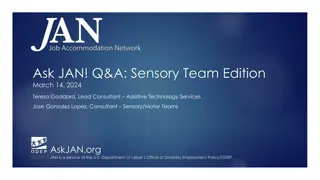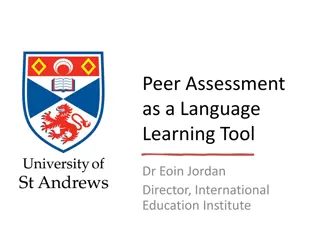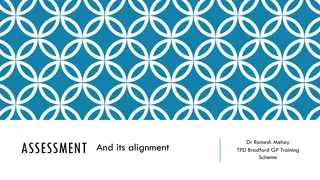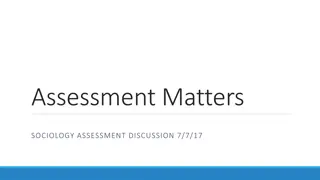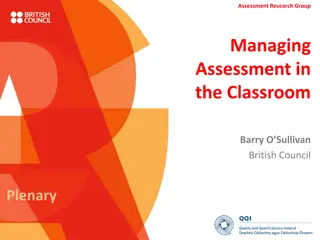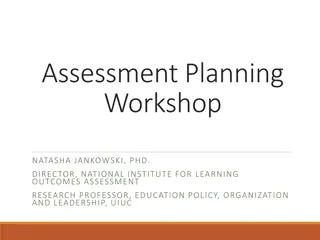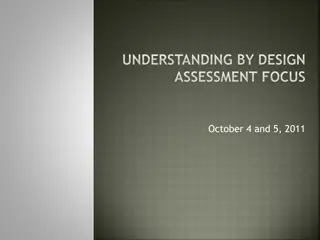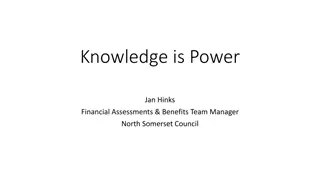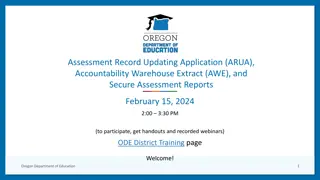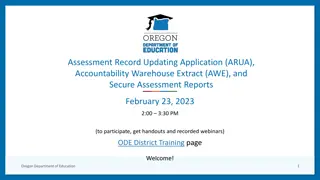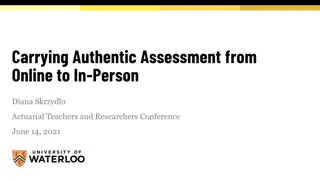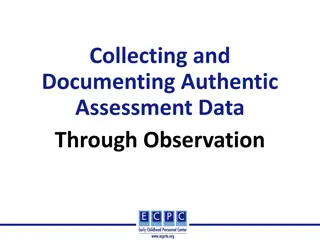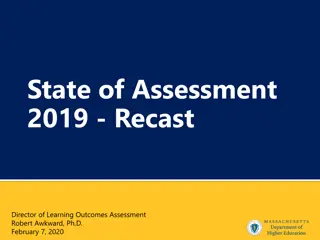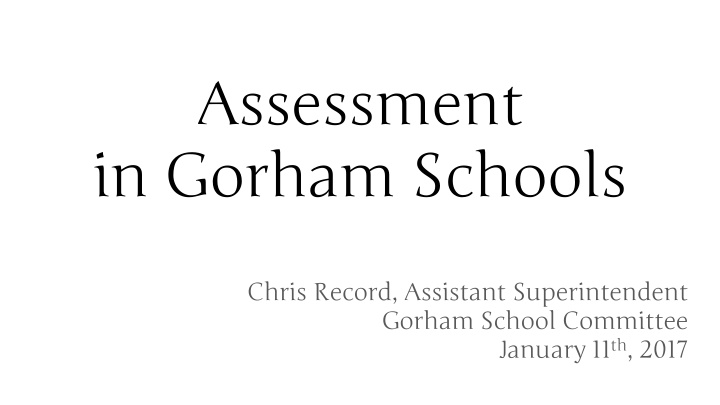
Enhancing Learning Through Effective Assessment Strategies
Explore the significance of assessments in Gorham schools, including types like formative and summative assessments, to support student learning, inform instruction, and meet educational standards. Learn how STAR assessments are utilized for intervention, enrichment, and monitoring progress over time.
Download Presentation

Please find below an Image/Link to download the presentation.
The content on the website is provided AS IS for your information and personal use only. It may not be sold, licensed, or shared on other websites without obtaining consent from the author. If you encounter any issues during the download, it is possible that the publisher has removed the file from their server.
You are allowed to download the files provided on this website for personal or commercial use, subject to the condition that they are used lawfully. All files are the property of their respective owners.
The content on the website is provided AS IS for your information and personal use only. It may not be sold, licensed, or shared on other websites without obtaining consent from the author.
E N D
Presentation Transcript
Assessment in Gorham Schools Chris Record, Assistant Superintendent Gorham School Committee January 11th, 2017
Why Assess? To measure what students know and are able to do To inform instruction To identify students for intervention or enrichment To monitor growth over time To inform students post-secondary planning To fulfill federal and state requirements
Two types of assessment Formative Classroom Assessments Formative Classroom Assessments: Inform instruction with specific & timely : Inform instruction with specific & timely feedback feedback Aligned to daily or weekly learning Aligned to daily or weekly learning objectives objectives Many Many types: teacher observation ( types: teacher observation (listening, body language assessment ( assessment (vote with thumbs, traffic lights vote with thumbs, traffic lights), student work ( organizers organizers), collaborative work ( ), collaborative work (think, pair, share; jigsaw listening, body language), student self ), student work (exit slips, graphic think, pair, share; jigsaw groups ), student self- - exit slips, graphic groups) ) May May be tracked in be tracked in gradebook gradebook Indicate Indicate need for reteaching need for reteaching and assessments assessments and/or /or readiness for summative classroom readiness for summative classroom
Two Types of Assessment Summative Classroom Assessments Summative Classroom Assessments: : evaluate student learning at the end of an instructional unit by comparing it against some standard or benchmark Aligned Aligned to course to course- - or grade or grade- -level performance level performance indicators indicators Many Many types: story, essay, test, project, poster, lab, debate, discussion, movie, types: story, essay, test, project, poster, lab, debate, discussion, movie, speech, report, skit, speech, report, skit, etc. etc. Tracked Tracked in in online online gradebook and converted to 1 gradebook and converted to 1- -4 or 0 4 or 0- -100 scale for reporting 100 scale for reporting
To Identify Students for Intervention or Enrichment & To Monitor Growth Over Time We Use STAR Assessments: Why STAR? 2-3 times per year / nationally normed / computer adaptive Consistent assessment tool K-10 Aligned to curriculum standards Provides immediate & specific information on each student (skills/standards) Provides instructional resources to teachers based upon student need Ability to progress monitor and build custom assessments
STAR Focus Areas Early Literacy (K Early Literacy (K 1) 1): diagnostic assessment of early literacy skills : diagnostic assessment of early literacy skills Reading Reading (1 independent readers independent readers (1 10): assessment of reading comprehension and skills for 10): assessment of reading comprehension and skills for Math (1 Math (1 10): assessment of math development in four domains 10): assessment of math development in four domains (numbers & operations, algebra, geometry & measurement, & data (numbers & operations, algebra, geometry & measurement, & data analysis/statistics/probability analysis/statistics/probability
To Inform Students Post-Secondary Planning Advanced Advanced Placement (AP) Placement (AP) Exams Exams at GHS at GHS AP AP 201 2016 6 171 171 students students participated participated ( (158 in 2015; 158 in 2015;148 148 in 2014; 138 in in 2014; 138 in 20 20 18 different course exams were taken 18 different course exams were taken 225 225 exams exams taken taken ( (213 in 2015; 213 in 2015; 185 185 in 2014; 175 in 2013) in 2014; 175 in 2013) 65 65 % % of test results were of test results were a 3 or higher a 3 or higher ( (60% in 2015; 60% in 2015; 62 62% in 2014; 60% in 2013 % in 2014; 60% in 2013) ) national = national = 57.9 57.9% %
To Fulfill Federal and State Requirements ESSA Every Student Succeeds Act ( ESSA Every Student Succeeds Act (No Child Left Behind Act of 2001 No Child Left Behind Act of 2001) ) R Requires equires annual testing in ELA/Literacy and Mathematics in grades 3 annual testing in ELA/Literacy and Mathematics in grades 3- -8 and 11 (Maine also tests in science) (Maine also tests in science) 8 and 11 ELA/Literacy ELA/Literacy and and Mathematics Mathematics Over the Years: Over the Years: 2009 2009- -2014: NECAP (Grades 3 2014: NECAP (Grades 3- -8), SAT (Grade 11) 8), SAT (Grade 11) 2014 2014- -2015 2015: MEA/SBAC (Grades 3 : MEA/SBAC (Grades 3- -8 and 11) 8 and 11) 2015 2015- -2016: MEA (3 2016: MEA (3- -8) and SAT (Grade 11) 8) and SAT (Grade 11) SAT Cut Scores: State expectations: 530 640 (Math) & 480 620 (ELA)
2016 ELA MEA Grades 3-5 ELA Well Below Below At State Above State 22% State 33% Grade 3 13% 33% State 24% 28% 27% 20% Grade 4 13% 28% 37% 22% State 25% 23% 32% 21% Grade 5 17% 24% 37% 22% State 23% 25% 35% 17%
2016 ELA MEA Grades 6-8 & SAT Results Well Below Below State Grade 6 9% 36% At State Above State 20% 35% State 16% 37% 32% 15% Grade 7 15% 26% 38% 21% State 18% 34% 34% 14% Grade 8 8% 38% 42% 13% State 15% 37% 37% 12% Grade 11 14% 12% 61% 12% State 22% 19% 46% 13%
2016 Math MEA & SAT Results for Gorham Math Well Below Below State 26% At State Above State 15% Grade 3 14% 45% State 22% 29% 38% 10% Grade 4 11% 35% 38% 15% State 20% 40% 28% 11% Grade 5 12% 32% 39% 16% State 21% 44% 26% 9%
2016 MEA Grades 6-8 & SAT Results for Gorham Grade 6 18% 38% 32% 12% State 31% 36% 23% 10% Grade 7 26% 26% 39% 9% State 31% 29% 31% 9% Grade 8 19% 34% 36% 11% State 34% 31% 25% 10% GHS Grade 11 State 14% 31.71% 39.51% 14.5% 26% 39% 27% 8%
2016 MEA Grades 5, 8, & 11 Results for Gorham Science Well Below Below At State Above State 10% State 20% Grade 5 7% 64% State 11% 26% 55% 8% Grade 8 3% 12% 62% 23% State 7% 20% 54% 19% Grade 11 15% 32% 47% 5% State 21% 33% 41% 6%


